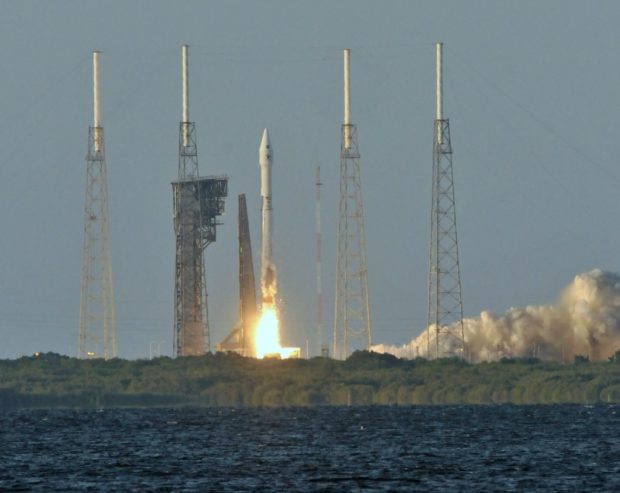NASA spacecraft to grab an asteroid sample

The United Launch Alliance Atlas V rocket carrying NASA’s Origins, Spectral Interpretation, Resource Identification, Security-Regolith Explorer (OSIRIS-REx) spacecraft lifts off on from Space Launch Complex 41 on September 8, 2016 at Cape Canaveral Air Force Station in Florida. The US space agency launched its first mission to collect dust from an asteroid, the kind of cosmic body that may have delivered life-giving materials to Earth billions of years ago. The unmanned spacecraft, known as OSIRIS-REx, blasted off at 7:05 pm (23:05 GMT) atop an Atlas V rocket in Cape Canaveral, Florida. (Photo by Bruce Weaver / AFP)
WASHINGTON— A NASA probe orbiting an asteroid over 100 million miles from Earth will make a perilous attempt on Tuesday to snatch a sample from the celestial body’s rocky surface to bring home the space agency’s first handful of pristine asteroid rocks.
NASA’s minivan-sized OSIRIS-REx spacecraft will begin a four-hour descent toward the rugged surface of the Bennu asteroid, whose acorn-shaped body, formed in the early days of our solar system, could hold clues to the origins of life on Earth, scientists say.
At 6:12 p.m. EDT, the spacecraft will be close enough to perform a meticulous five-second ‘touch-and-go’ technique by autonomously extending its 11-foot (3.35 m) robotic arm toward a flat patch of gravel roughly the size of a basketball court near Bennu’s north pole.
“A lot of things could go wrong because the spacecraft’s about the size of a van, and the asteroid has a lot of boulders in it,” Lucy Lim, a planetary scientist at NASA, said. “So we have to go between the boulders to get our sample, and a lot of planning went into that.”
The spacecraft launched in 2016 from Kennedy Space Center for the journey to Bennu. It has been in orbit around the asteroid for nearly two years preparing for the “touch and go” maneuver.
A collection device attached to the arm and shaped like an oversized shower head will ‘touch’ Bennu’s surface for five seconds and shoot out a burst of nitrogen gas, kicking up debris and entrapping rocky material inside the device’s sampling head.
If successful, ground controllers will confirm capture of Bennu remnants a few hours after the attempt. That will allow the spacecraft to start its journey back toward Earth arriving in 20230 to return the first U.S. cache of pristine asteroid rocks. Japan is the only other country to accomplish this before.
Asteroids are among the leftover debris from the solar system’s formation some 4.5 billion years ago.
Scientists believe asteroids and comets crashing into early Earth may have delivered organic compounds and water that seeded the planet for life. Atomic-level analysis of samples from Bennu could provide key evidence to support that hypothesis.